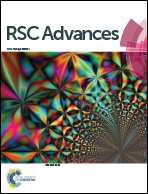Low temperature Au induced crystallization of titanium dioxide thin films for resistive switching applications
Abstract
Metal induced decrease of crystallization temperature of sol–gel derived titanium dioxide (TiO2) thin films is reported. It is shown that the Au induced onset of crystallization occurs at a temperature of 250 °C as compared to 400 °C when it is deposited directly on the same substrate. The crystallization process is probed using X-ray diffraction and confirmed by Raman spectroscopy. The onset of crystallization is evidenced by the appearance of the diffraction peak from the (101) plane of anatase TiO2 and the peak due to A1g + B1g Raman mode at 515 cm−1. Polarized optical microscopy and Raman imaging indicated that the spatial spread of crystallization across the surface of the film increases with the increase in temperature. Unipolar resistive switching is demonstrated by fabricating an Au/TiO2/Au stack, which shows formation at 9 V, set voltage of 0.5 V and reset voltage of 3.3 V. The maximum set–reset resistance ratio achieved was 105. The mechanism of resistive switching is established by a correlation with photoluminescence spectra which indicates the presence of defects that aid in the switching process.


 Please wait while we load your content...
Please wait while we load your content...